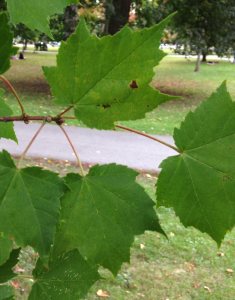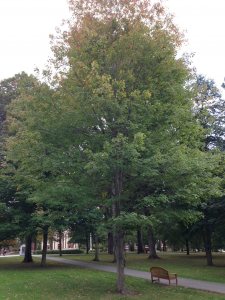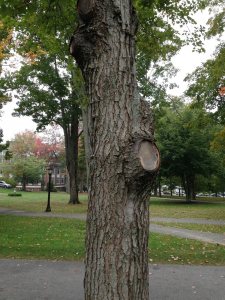Red Maple
Acer rubrum | Family: Sapindaceae
Submission: Madeline McGonagle ‘18
Leaves – Generally 3-lobed, serrate, with the sides of the terminal lobe often convergent; glaucous below.
Flower – One of the first trees to flower in the spring with small red flowers that hang in clusters.
Twigs – Opposite branching; without fetid odor, compared to silver maple; reddish and lustrous; leaf scars are v-shaped with 3 bundle scars; slightly stalked lateral buds.
Buds – Imbricate with reddish scales; slightly stalked lateral buds; terminal buds clustered at tip of branch.
 Fruit – ½ to ¾ inch samaras with slightly divergent wings; mature in late spring to early summer.
Fruit – ½ to ¾ inch samaras with slightly divergent wings; mature in late spring to early summer.
Bark – Gray scaly plates, variable, and often with “targets.”
Natural History:
Red Maple (Acer Rubrum), is also known as soft, swamp, or white maple. This tree is native to North America, but most commonly found in New England, the Mid-Atlantic, upper Michigan, and Northeast Wisconsin. Red Maple is a shade tolerant tree, meaning it is able to thrive with low levels of light. It is a medium sized tree, reaching average heights of 50-60 feet with diameters of 1-2 feet and grows on a variety of sites with varying elevation, soil type, pH, and wetness. Red Maple is commonly used for pulp and firewood, but may also be used for canoe paddles, furniture, or pallets. The young branches of red maple serve as an important source of food for wildlife like elk and white-tailed deer.
References:
Burns, R.M. and Honkala, B.H., 1990. Silvics of North America (Vol. 2). United States Department of Agriculture.
Brockman, C.F. 1986. Trees of North America: A Guide to Field Identification. Revised Edition. Western Pub. Co., Inc. 280pp.
Elias, T.S. 1980. The Complete Trees of North America Field Guide and Natural History. Van Nostrand Reinhold Co., N.Y. 948pp.
Harlow, W.M., Harrar, E.S., Hardin, J.W. and White, F.M. 1991. Textbook of Dendrology. McGraw-Hill Inc., N.Y. 501pp.
Maine Forest Service, 2008. Forest Trees of Maine: 1908-2008. Polar Bear & Co.
Petrides, G.A. 1972, A Field Guide to Trees and Shrubs. 2nd edition. Houghton Mifflin Co., Boston. 428pp.
Preston, R.J., Jr. 1989. North American Trees. 4th edition. Iowa State Univ. Press. Ames. 407pp.
Shane, J. 2004. Dendrology Handbook, University of Vermont, Unpublished.

